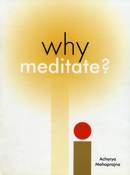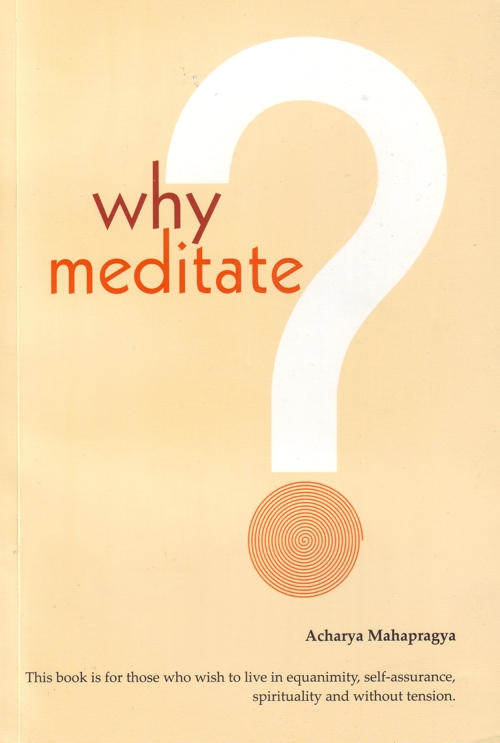
 A practitioner of Preksha meditation should know that he has to develop a balance. Just sitting in meditation, and closing your eyes for an hour, is not the objective of meditation. Meditation aims to rejuvenate our physical, mental, vocal and spiritual power. I saw Acharya Tulsi at the age of 83. The day he passed away, he completed almost 40 tasks, with his day going from 4 a.m. till 11.15 p.m. He talked to someone, directed another. Analysing his work on that day we found that he accomplished almost 40 different tasks. How could he do so much work at the age of 83? The reason is that his luminous body was strong and powerful. He left the world because his life span was completed, not because of any disease or illness. His luminous body was so vigorous that he kept on working right until the end. He never stopped work.
A practitioner of Preksha meditation should know that he has to develop a balance. Just sitting in meditation, and closing your eyes for an hour, is not the objective of meditation. Meditation aims to rejuvenate our physical, mental, vocal and spiritual power. I saw Acharya Tulsi at the age of 83. The day he passed away, he completed almost 40 tasks, with his day going from 4 a.m. till 11.15 p.m. He talked to someone, directed another. Analysing his work on that day we found that he accomplished almost 40 different tasks. How could he do so much work at the age of 83? The reason is that his luminous body was strong and powerful. He left the world because his life span was completed, not because of any disease or illness. His luminous body was so vigorous that he kept on working right until the end. He never stopped work.
When does our luminous body become vigorous? Wherever there are practices of restraint of the senses and mind, abstinence from the enjoyment of worldly objects and controlled desires, the luminous body becomes powerful. Man weakens his luminous body by his own activities and behaviour and, hence, cannot live his life completely. Mostly people die a premature death. People dying early out of accidents are only 15-20%. The remaining 80% (barring a minor 1 or 2%) die earlier than their actual life span. They cannot enjoy their complete life span because they have weakened their luminous body by wasting its energy. Someone's liver has broken-down, someone's heart is weakened and someone's kidney is malfunctioning. Actually, our organs are not weakened. They are strong and have the potential to function, but by our unbalanced and unrestrained activities, we remain ignorant of how to maintain a balance between action and inaction, and the resultant imbalance of our nervous system makes our organs impotent or powerless.
Aasan (different postures of body) revitalizes our organs. We should select those Aasans' which can restore our energy. Kayotsarg is of course the best technique amongst all. In Kayotsarg there is a total abandonment of actions. Where there is abandonment and total relaxation, the flow of energy automatically resumes.
The first practice for physical health is Aasan. These are of two types. Some of them are meant for meditation (Dhyanasan) like Padmaasan, lotus posture, Ardhapadmaasan, half-lotus posture, Sukhaasan, simple cross-legged posture, Vajraasan, prayer posture etc. These are both meditative (Dhyanasan) as well as for physical well being (Shariraasan). Those people having weak digestive systems should sit in Vajraasan for 10-20 minutes after meals. This would strengthen their digestive system. Those suffering from knee-pain should practice Taadaasan (palm tree exercise, standing on the toes and stretching the whole body). Specific Aasans are prescribed for each and every organ of our body. There are Aasans for liver, pancreas, intestines and colon. Regular practice of Aasans is necessary for maintaining our physical health.
The second practice for maintaining physical health is Praanaayaam. It means control and regulation of Praan (vital energy). The fundamental characteristic of Praanaayaam is Kumbhak (holding breath). Then Rechak (exhalation) and Purak (inhalation) also follow. This lets the fresh air and healthy particles in, while throwing out the toxins and unhealthy particles. The practice of Praanaayaam revitalizes our body. An ill man feeling very weak and feeble, when endorsed to practice Praanaayaam for 10-20 minutes by an expert practitioner would experience a new vitality in his body, with increased vital energy. He would feel rejuvenated and refreshed.
So on one hand, there is medication for maintaining good health, and on the other hand, there is meditation. Meditation helps us to progress in the realm of spirituality. It enhances the inner powers and controls the mind. If you want to discover how good health can be maintained by the practice of meditation, this may not be so feasible. To attain good health is not the true objective of meditation. It only assures us that if there is an imbalance of vital energy in our body, meditation will help us in restoring that energy balance. Meditation cannot cure any physical ailments. For that, it is necessary to practice Aasana and Praanaayaam. In the schedule of Preksha meditation, Aasana and Praanaayaam form a part of the practice. It should not be practiced only for ten days but is a lifelong practice. Aasan and Praanaayaam should be practiced every day. As important as it is to eat food, it is even more important to purify Apaan (foul air) and even more important to practice Aasana and Praanaayaam. The area from the belly button to the bottom of the spinal cord (the centre of energy or Mulaadhaar Chakra) is the area of Apaan Praan. One whose Apaan Praan is not pure will remain ill, weak and uneasy. This area is the fundamental place of our power supply. If that area is not pure, how can we remain healthy? We must take good care to see that this region remains clean and pure. This also requires regulating our food habits, so that this region does not get defiled.
Preksha meditation is not just a procedure of meditation. It is accompanied with the practices of mantras, will power, Aasan and Praanaayaam. Hence it has a holistic approach of our life and not a mere meditating technique. The sonic vibrations created by chanting of mantras and will power also play an important role in it.
A spiritual seeker (Mumukshu) sister once told me," Gurudev! My liver is severely infected. I've done all that is necessary. I have taken medications from several allopathic and Ayurvedic doctors but to no avail. I am really troubled." I asked her to practice chanting on liver and pancreas. The seed mantra of Jainism is " Hraam, Hrim, Hroom, Hraim, Hrah", etc. She practiced chanting these seed mantras with full faith for about three months. After three months, the doctor diagnosed her liver and said, "Everything is normal, your liver is completely cured, there is no problem at all."
The one, which could not be cured by medication, was cured by practice of chanting of mantras. We should not steer clear of chanting mantras. No one can meditate for all the twenty-four hours of a day. During the shivir (camp) if someone is asked to meditate for 24 hours, it is a moot point whether he would be able to meditate or he would go mad. We have seen some people go mad. Many people have come to me and complained that someone made them meditate for long and that disturbed their mental balance. It is not good to meditate for long right in the beginning. Relaxation (Kaayotsarg) is, however, an exception. You can do it as many times as you like. Other than this, the practices of meditation, concentrating the mind, Aasana, etc should be done for a limited time. About 30-45 minutes of practice is enough for beginners.
It is very aptly said that "Diseases are not of one single kind and hence their cure cannot be of one kind." We see in the 'Mantra Philosophy' that for curing different diseases, different mantras have been prescribed. Even Ayurvedic and allopathic doctors provide different medications for different ailments. Just having one piece of dry ginger does not turn one into a grocer. So we should renounce the belief that one kind of technique or practice can solve all problems.
Our Karmas are very strange. We have several different problems and therefore several varied solutions. That problem which cannot be solved by medication may be solved by Aasans, another problem unsolved by Aasans may be solved by Praanaayaam and yet another, which remains unsolved by any of these, can perhaps be resolved by chanting mantras. We have to understand the procedure of meditation in the perspective of Anekanta or non-absolutism. Absolutism, i.e. emphasis on one should not be our vision. In the camps of Preksha meditation, we never emphasized complete absolute silence, (Maun). At times, we made people practice Maun for about ten days but that produced a kind of suffocation. Hence, we formulated the method, �Avoid unnecessary talk but you can speak whenever it is necessary�. Because, if in Maun, you make indications like: wmm, aa, etc., it would dissipate even more energy and cause frustration.
Emphasis on one technique cannot be fruitful. The procedure of Preksha meditation is based on the perspective of non-absolutism. Hence, we should understand this also in a non-absolutist context. We have many problems and to resolve those problems, we must resort to different solutions. In this context, when we discuss about our physical health, we must consider all the different aspects connected with our physical health. We must employ them thoroughly and we will then be able to resolve the problems emerging from within us. Only then can we develop a healthy personality.
 Acharya Mahaprajna
Acharya Mahaprajna
 Copyright by Acharya Mahaprajna ©2005
Copyright by Acharya Mahaprajna ©2005